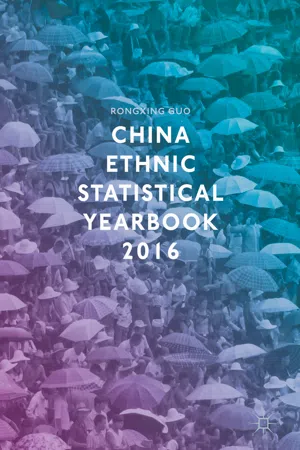
- English
- PDF
- Available on iOS & Android
China Ethnic Statistical Yearbook 2016
About This Book
This book, comprised of entirely original research, collects data on the socioeconomic situation of China's 56 ethnic groups.Although the majority of China's population is of the Han nationality (which accounts for more than 90% of China's population), the non-Han ethnic groups have a population of more than 100 million. China has officially identified, except for other unknown ethnic groups and foreigners with Chinese citizenship, 55 ethnic minorities. In addition, ethnic minorities vary greatly in size. With a population of more than 15 million, the Zhuang are the largest ethnic minority, and the Lhoba, with a population of only about three thousand, the smallest.
China's ethnic diversity has resulted in a special socioeconomic landscape for China itself. However, till presently, a complete socioeconomic picture of China's ethnic groups – especially of its smallest ethnic minorities – still remained unclear. How different have China's ethnic groups been in every sphere of daily life and economic development during China's fast transition period? In order to answer these questions, we have created a detailed and comparable set of data for each of China's ethnic groups.
This book presents, in an easy-to-use format, a broad collection of social and economic indicators on China's 56 ethnic groups. This useful resource profiles the general social and economic situations for each of these ethnic groups. These indicators are compiled and estimated based on the regional and local data gathered from a variety of sources up to 2012.
Frequently asked questions
Information
Table of contents
- Preface
- A List of 56 Ethnic Groups in China
- Maps
- Acknowledgments
- Organization of this Book
- Contents
- List of Tables
- 1: Population Growth and Structural Change
- 2: Macroeconomic Growth and Structural Change
- 3: Employment and Income Distribution
- 4: Living Conditions and the Means of Livelihood
- 5: Agricultural Production and Other Rural Activity
- 6: Education, Science and Technological Progress
- 7: Health Care and Social Security
- 8: Entertainment and Other Cultural Activity
- Appendix 1. A Brief Description of China’s 56 Ethnic Groups
- Appendix 2. China’s Ethnic Populations by Province
- Appendix 3. China’s Ethnic Minority Autonomous Areas: General Background
- Appendix 4. China’s Ethnic Minority Autonomous Areas: Principal Statistical Indicators
- Notes on the Text
- Index